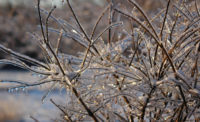Deck the halls - safely
NFPA's "Project Holiday" campaign puts focus on fire safety

When you’re decking the halls this year, make sure to keep fire safety in mind. That’s the main message behind “Project Holiday,” the National Fire Protection Association’s (NFPA) annual holiday fire safety campaign, which works to educate the public about the increased risk of home fires during the holiday season.
When decking the halls this holiday season, follow NFPA's simple safety tips to help keep yourself and your family and friends safer from fire.
“The holidays carry a host of traditions and festivities that people look forward to all year. Unfortunately, many of these activities carry hidden dangers that present potential fire hazards,” said Lorraine Carli, NFPA’s vice president for Outreach and Advocacy.
A dangerous month
Holiday decorations, Christmas trees, candles and cooking all contribute to an increased number of home fires during December, making it one of the four leading months for U.S. home fires. Consider these facts:
Holiday cooking: While cooking fires are the leading cause of U.S. home fires and injuries year-round, Christmas Day and Christmas Eve ranked second and third (after Thanksgiving) as the leading days for home cooking fires. On Christmas Day in 2013, there was a 58 percent increase in the number of home cooking fires than on a typical day, and a 54 percent increase on Christmas Eve.
Christmas trees: Christmas tree fires are not common, but when they do occur, they’re much more likely to be deadly than most other fires. One of every 31 reported home Christmas tree fires results in a death each year, compared to an annual average of one death per 144 total reported home fires.
Candles: December is the peak time of year for home candle fires; the top four days for home candle fires are New Year’s Day, Christmas, New Year’s Eve and Christmas Eve. In December, 11 percent of home candle fires began with decorations, compared to 4 percent the rest of the year.
Holiday decorations: Between 2009 and 2013, U.S. fire departments responded to an annual average of 860 home fires that began with decorations (excluding Christmas trees). These fires caused an annual average of one civilian death, 41 injuries and $13.4 million in direct property damage. One fifth (20 percent) of the decoration fires started in the kitchen; one out of six (17 percent) started in the living room, family room or den.
Simple precautions
“Fortunately, with some added awareness and by taking some simple safety precautions, people can ensure a safe and festive holiday season,” said Carli. “That’s what ‘Project Holiday’ is all about.”
“Project Holiday” offers a host of online tips and resources for consumers, along with tools and resources for local fire departments to promote the campaign and its safety messages in their communities.
About the National Fire Protection Association (NFPA)
Founded in 1896, NFPA is a global, nonprofit organization devoted to eliminating death, injury, property and economic loss due to fire, electrical and related hazards. The association delivers information and knowledge through more than 300 consensus codes and standards, research, training, education, outreach and advocacy; and by partnering with others who share an interest in furthering the NFPA mission. For more information visit www.nfpa.org. All NFPA codes and standards can be viewed online for free at www.nfpa.org/freeaccess.
Looking for a reprint of this article?
From high-res PDFs to custom plaques, order your copy today!





